

Pig-Human Chimeras Have a 'Safety Switch' To Prevent Sentience. History’s first pig-human hybrids have been grown in a lab, stoking fears of a porcine mutant apocalypse.
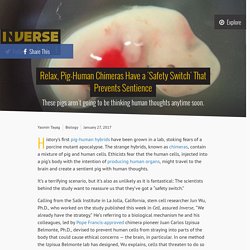
The strange hybrids, known as chimeras, contain a mixture of pig and human cells. Ethicists fear that the human cells, injected into a pig’s body with the intention of producing human organs, might travel to the brain and create a sentient pig with human thoughts. It’s a terrifying scenario, but it’s also as unlikely as it is fantastical: The scientists behind the study want to reassure us that they’ve got a “safety switch.” Calling from the Salk Institute in La Jolla, California, stem cell researcher Jun Wu, Ph.D., who worked on the study published this week in Cell, assured Inverse, “We already have the strategy.” “If we let the gestation go for longer, then we need to start to incorporate this safety switch,” he says. A federal safety board just OK’d the first CRISPR trial to genetically alter humans. In the spring of 2015, a group of Chinese scientists modified the DNA of 54 embryos using CRISPR/Cas 9 technology.

Twenty-eight of those embryos were successful, but 26 — nearly half of them — failed, setting off a heated debate throughout the scientific community on the ethics of altering human genes. Regulators don’t currently allow the use of CRISPR on human DNA in the United States, but researchers from the University of Pennsylvania have proposed the first human study using the technology. The proposal would allow these researchers to make T cells with the ability to attack three inherited types of cancer. A federal biosafety and ethics panel gave Penn the go-ahead earlier today to conduct research on human patients, but the idea will still need approval at the proposed medical centers where the research will potentially be conducted, and will need the OK from the Food and Drug Administration. Leaving Facebook... TECHNOMATERNITÉ ET TRANSHUMANISME par Laurent Alexandre. OsBot Human Bone Replicating 3D Printer will be ready soon? Advances in 3D printing technology have begun to have a transformative effect on the medical community.
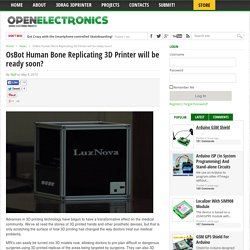
We’ve all read the stories of 3D printed hands and other prosthetic devices, but that is only scratching the surface of how 3D printing has changed the way doctors treat our medical problems. MRI’s can easily be turned into 3D models now, allowing doctors to pre-plan difficult or dangerous surgeries using 3D printed replicas of the areas being targeted by surgeons. They can also 3D print surgical guides, making tricky procedures like bone setting or reconstructive surgery faster and more accurate. 2 étudiantes floridiennes inventent le tatouage éthylotest ! This Machine Guides Your Hand to Teach You How to Draw. Datta’s Force Finger contraption.

Saurabh Datta Good news for people without natural born talent: You don’t need it. DARPA Robots Transhumanisam Review 2012. We Try a New Exoskeleton for Construction Workers. Russ Angold, the co-founder and CTO at exoskeleton maker Ekso Bionics, says he can tell how old someone is by which pop-culture reference they make when he tells them what he does for a living.
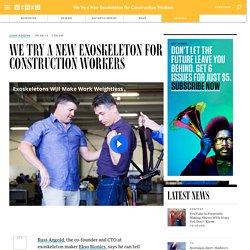
Kids talk about the suit Tom Cruise wears in Edge of Tomorrow. Millenials name-check Iron Man. Gen-Xers go classic: Sigourney Weaver in Aliens. Nobody ever mentions Starship Troopers. But building a power-enhancing exosuit isn’t easy. Ekso started out trying to build Iron Man suits for the military, then spread into the world of physical therapy, with powered walking suits that help people learn to walk again after strokes or accidents.
Click to Open Overlay Gallery The key to typical exoskeletons is power. The industrial exoskeleton doesn’t care about that, though. The effect is unsettling. Angold had warned me about this, I realized. So by and large the suit works as advertised. Man sees with 'bionic eye' «Nous construisons Iron Man»: pourquoi cette blague de Barack Obama n'en est pas une. La formule a eu le don de provoquer l'hilarité.

L'utérus artificiel. New 3D bioprinter to reproduce human organs, change the face of healthcare: The inside story - Feature. Researchers are only steps away from bioprinting tissues and organs to solve a myriad of injuries and illnesses.
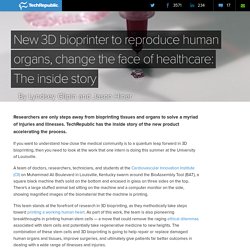
TechRepublic has the inside story of the new product accelerating the process. If you want to understand how close the medical community is to a quantum leap forward in 3D bioprinting, then you need to look at the work that one intern is doing this summer at the University of Louisville. Le nouvel Adam naîtra de la fusion avec les machines. Société et technologies Les transhumanistes annoncent l’émergence d’une nouvelle forme d’humanité réservée à une élite.

Certains promettent même l’immortalité. On pourrait en rire si Google et les militaires n’étaient pas de la partie. «Nous serons comme des dieux. Les gens ne veulent pas l’entendre, mais nous serons omniscients. Vous avez dit «Singularité»? Greg Gage: How to control someone else's arm with your brain. Un amputé des deux bras bouge ses prothèses par la pensée. Amputé des deux bras, Les Baugh déplace un objet en contrôlant ses prothèses par la pensée. © Johns Hopkins University Applied Physics Laboratory.
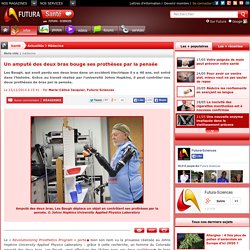
VIDEO. Amputé des deux bras, il réussit à contrôler ses prothèses bioniques avec l'esprit. C'est un petit geste pour l'homme et un grand espoir pour les personnes amputées.

Les Baugh, un Américain amputé des deux bras à hauteur des épaules depuis un accident survenu il y a quarante ans, a réussi à faire bouger ses deux bras bioniques par la pensée. Cette première a eu lieu dans le Colorado à l'Université Johns Hopkins, qui a révélé l'exploit cette semaine.